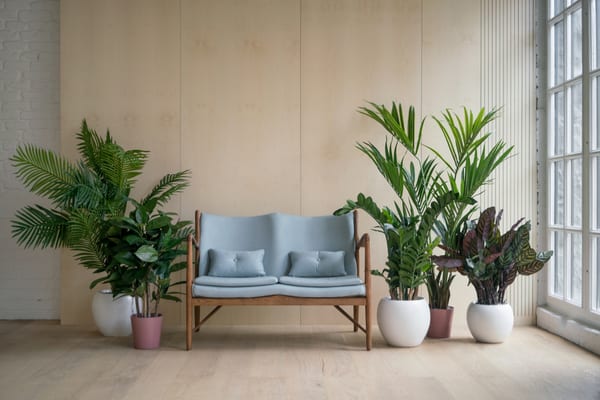A desire to reconnect with nature is an innate reaction to the stresses of our world. You already know that adding a plant to a room provides a pop of fresh color and can even help purify the air you breathe, but depending on the house plants you choose, you can transport yourself from the dead of winter to a sunny tropical isle, bringing exotic flair to your home. “Nature has a soothing effect on us, so we have an instinct to bring the outdoors in,” says interior designer Justina Blakeney. “Bringing colors, textures, and, of course, plants into a home is a great way to keep the flow between indoors and outdoors going, and it’s a great way to incorporate the good vibes the natural world has to offer.”
These tropical plants can be grown indoors to bring a bit of the jungle or rainforest into your living room, bath, or bedroom.
Ficus are fussy, yes, but a well-grown ficus is near the pinnacle of houseplants. Large, glossy, and imposing, ficus plants are well worth the effort. The ficus is a member of the fig family.
Dumb Cane (Dieffenbachia) are almost ubiquitous as houseplants, so it’s easy to forget they’re also a true tropical foliage plant. Watch out for the sap on these plants—it can be caustic. You should wear gloves when handling them.
Cordyline are virtually synonymous with the tropics. A relative of the ti plant, these bold and colorful foliage plants are available in a wide array of leaf colors, and with proper care, can provide a dramatic accent.
Bromeliads are probably the easiest of all tropical plants to grow. These tropical epiphytes (air plants) are easily adapted to growing in pots, and they’re much more tolerant than many of their lush-leaved colleagues. They come in a wide array of colors and textures.
Bird of Paradise (Strelitzia) is one of the most tropical flowers in the world, with an almost gaudy array of blue and orange plumage. Fortunately, they’re also surprisingly easy to grow indoors. This plant thrives in sunny spaces, so stick her in a space with lots of windows. As far as watering goes, it couldn’t be easier. Birds of Paradise only need to be watered occasionally when the soil is completely dry. When you do water it, hydrate the soil until it is saturated but not soggy. To keep the leaves glossy, spritz them with a water bottle once or twice a week. During the fall and winter months, water less frequently.
Amazon Elephant’s Ear (Alocasia amazonica) are common but distinctive and almost regal. Large, arrow-shaped green leaves are ribbed with silver. They are much easier to grow inside than most Alocasia species and provide seasonal displays of wonderful foliage. This plant originated in Southeast Asia. It is poisonous, so use caution with children and pets.
Palm Trees are the enduring symbol of everything tropical, and there is a selection of palms (like the Areca or Kentia, Queen Victoria’s favorite) that are easy to grow indoors. You can enjoy them in your entryway or the corner of a sunny room and be taken back to your tropical vacation.
Philodendrons. For indoor use, there are climbing varieties and the self-heading (non-climbing) types. Newer hybrids have been bred that mix the vigor and ease of the climbing varieties with the convenience of the self-heading varieties. It’s easier than ever to grow them.
Schefflera, or Umbrella Plants have leaves that are broad, glossy and abundant. Use them as background plants, or use a big one in a bright, warm corner for a nice canopy effect.
Orchids are the most varied of all plant groups—they range all over the world, from deserts to woodlands to tropical forests. They can be fussy and have specific watering needs, but the orchids most people love are the tropical and subtropical ones, and what says “tropics” more than a flowering orchid?
Snake Plant. One of the most well-known air-purifying houseplants, the Snake Plant is gorgeous and super easy to care for. The Snake Plant can survive in any level of light except bright, direct sunlight. So if you’re looking for a plant to brighten up the corner of a dark room, this is the one! Plan to water this plant with 4-6 ounces of water every 10 days except during the winter months, when you should only water it once a month. Seriously, it’s almost impossible to kill. However, its leaves are toxic to pets, so please be mindful of where you place it in your home.
Rubber Tree is not only easy to care for, it has the potential to reach heights of up to eight feet! Now that is some serious greenery. The Rubber Tree thrives in medium to bright light and in temperatures between 60 and 80 degrees. Water the soil until it is completely saturated and only water when the soil’s surface becomes completely dry—usually once a week. It doesn’t get easier than that! Please keep in mind that this plant can be harmful to pets if ingested.
Arthurium is a classy tropical that is highly prized for its stately, bright flowers. Also known as the Painted Tongue, the Tail Flower and the Flamingo Flower, this red blooming plant, native to the forests of Central and South America, provides serious eye candy year-round. This plant prefers a coarse, well-draining soil, an ideal mix being equal parts peat moss, perlite and pine bark. As this plant can easily burn, avoid placing it in direct sunlight. Water thoroughly once or twice a week and allow soil to dry completely between watering sessions. During the winter, discontinue watering for six weeks. Doing so allows the plant to flower plentifully in the following season. This plant can be harmful if ingested so keep out of the reach of small children and pets.
—
Photo Credit: Kate Aedon / Shutterstock.com
